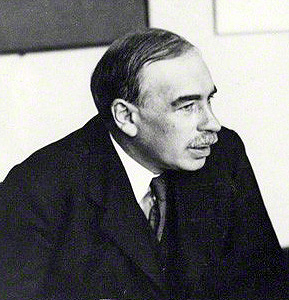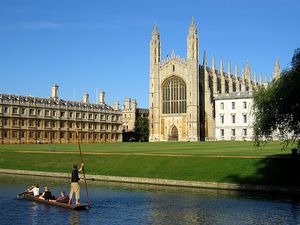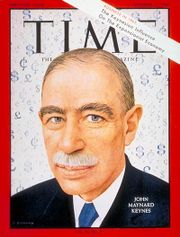جون مينارد كينز
The Lord Keynes | |
|---|---|
 Keynes in 1933 | |
| وُلِدَ | 5 يونيو 1883 كمبريدج، إنگلترة |
| توفي | 21 أبريل 1946 (aged 62) |
| التعليم | |
| الحزب | Liberal |
| الزوج | Lydia Lopokova (ز. 1925) |
| الوالدان |
|
| Academic career | |
| الهيئة | King's College, Cambridge |
| المجال | |
| المدرسة أو التقليد | كينزية |
| تأثر بـ | |
| إسهامات | |
| جزء من سلسلة عن |
| علم الاقتصاد الكلي |
|---|
 |
جون مينارد كينز[3] ( John Maynard Keynes ؛ /keɪnz/ KAYNZ ؛ 5 يونيو 1883 - 21 أبريل 1946) اقتصادي وفيلسوف انجليزي whose ideas fundamentally changed the theory and practice of macroeconomics and the economic policies of governments. Originally trained in mathematics, he built on and greatly refined earlier work on the causes of business cycles.[4] One of the most influential economists of the 20th century,[5][6][7] he produced writings that are the basis for the school of thought known as Keynesian economics, and its various offshoots.[8] His ideas, reformulated as New Keynesianism, are fundamental to mainstream macroeconomics. He is known as the "father of macroeconomics".[9]
During the Great Depression of the 1930s, Keynes spearheaded a revolution in economic thinking, challenging the ideas of neoclassical economics that held that free markets would, in the short to medium term, automatically provide full employment, as long as workers were flexible in their wage demands. He argued that aggregate demand (total spending in the economy) determined the overall level of economic activity, and that inadequate aggregate demand could lead to prolonged periods of high unemployment, and since wages and labour costs are rigid downwards the economy will not automatically rebound to full employment.[10] Keynes advocated the use of fiscal and monetary policies to mitigate the adverse effects of economic recessions and depressions. He detailed these ideas in his magnum opus, The General Theory of Employment, Interest and Money, published in early 1936. By the late 1930s, leading Western economies had begun adopting Keynes's policy recommendations. Almost all capitalist governments had done so by the end of the two decades following Keynes's death in 1946. As a leader of the British delegation, Keynes participated in the design of the international economic institutions established after the end of World War II but was overruled by the American delegation on several aspects.
Keynes's influence started to wane in the 1970s, partly as a result of the stagflation that plagued the Anglo-American economies during that decade, and partly because of criticism of Keynesian policies by Milton Friedman and other monetarists,[11] who disputed the ability of government to favourably regulate the business cycle with fiscal policy.[12] The advent of the global financial crisis of 2007–2008 sparked a resurgence in Keynesian thought. Keynesian economics provided the theoretical underpinning for economic policies undertaken in response to the financial crisis of 2007–2008 by President Barack Obama of the United States, Prime Minister Gordon Brown of the United Kingdom, and other heads of governments.[13]
When Time magazine included Keynes among its Most Important People of the Century in 1999, it reported that "his radical idea that governments should spend money they don't have may have saved capitalism".[14] The Economist has described Keynes as "Britain's most famous 20th-century economist".[15] In addition to being an economist, Keynes was also a civil servant, a director of the Bank of England, and a part of the Bloomsbury Group of intellectuals.[16]
اشتغل في بداية حياته في الهند وألف كتابا عن الاصلاح فيها واشترك في مؤتمر السلام بعد الحرب العالمية الأولى.
أحدث ثورة في علم الاقتصاد، وذاعت شهرته في العالم. وُلِد كينز في كمبردج من مقاطعة كمبردجشاير في حزيران وتوفي في نيسان في فيرل من مقاطعة سسكس. عمل في الصحافة وفي النشاط المالي لكنه أُشتهر بتثويره علم الاقتصاد بما عرف لاحقاً بالاقتصاد الكينزي. و كتب كتابا بعنوان (الاثار الاقتصادية للسلام).
. . . . . . . . . . . . . . . . . . . . . . . . . . . . . . . . . . . . . . . . . . . . . . . . . . . . . . . . . . . . . . . . . . . . . . . . . . . . . . . . . . . . . . . . . . . . . . . . . . . . . . . . . . . . . . . . . . . . . . . . . . . . . . . . . . . . . . . . . . . . . . . . . . . . . . . . . . . . . . . . . . . . . . . .
حياته الشخصية

هو ابن جون نيفيل كينز,أستاذ اقتصاد في جامعة كامبردج, و كاتب في الاصلاح الاجتماعي.و لديه أخ و أخت الأخ هو جيفري كينز 1887-1982 وكان يحب جمع الكتب وأخته مارجريت تزوجت الفائز بجائزة نوبل في الفسيولوجيا أرشيبالد هل. كان مستثمرا ناجحا و بنى ثروة ضخمة, الا انه في انهيار 1929 أشرف على الافلاس و لكنه عاد ليبني ثروته من جديد.
وكان تلميـذاً للاقتصادي المشهور ألفرد مارشال، ثم أصبح أستاذاً للاقتصاد في كلية كينغ. خلّف كثيراً من المؤلفات التي تُرجم معظمها إلى اللغات الأجنبية، وتُرجم بعضها إلى العربية. من مؤلفاته «النتائج الاقتصادية للسلام» (1919)، «بحث في الإحتمالات» (1921)، «الإصلاح النقدي» (1923)، «بحث في النقود» (1930)، وكتابه المشهور جداً «النظرية العامة في العمالة والفائدة والنقود» (1936) الذي كان لـه دور كبير في تخليص علم الاقتصاد من جمودية المدرسة التقليدية (الكلاسيكية).
بعد تخرجه في جامعة كمبردج، عمل كينز موظفاً مدنياً، ثم إنتقل إلى مكتب الهند في وزارة الدفاع البريطانية ، ونتيجة لذلك تولى مهمة كبرى في تدقيق الوضع المالي والنقدي الهندي قبل الحرب العالمية الأولى. مع اندلاع الحرب عاد إلى العمل في الخزينة البريطانية مسؤولاً عن العلاقات مع حلفاء بريطانيا، بشأن توفير العملات الأجنبية لتمويل الحرب.
بعد نهاية الحرب شارك كينز في مؤتمر الصلح في فرساي، ووقف ضد شروط التعويضات القاسية التي فرضت على ألمانيا المهزومة، وأصدر بعد ذلك كتابه «النتائج الاقتصادية للسلام» مما أفقده مكانته لدى الحكومة البريطانية وحلفائها، ولكن ما لبثت الحياة أن أثبتت صحة توقعاته، فأعيد اعتباره ومُنح لقب لورد تيلتون، وشارك في اجتماعات بريتون وودز عام 1944، وقدَّم مشروعاً لإصلاح النظام النقدي العالمي على أساس عملة عالمية موحدة باسم بانكور. لم يؤخذ بمشروع اللورد كينز؛ لأن الولايات المتحدة فرضت مشروعها المعروف باسم مشروع وايت.
تضمن كتابه الأخير المعروف إختصاراً باسم «النظرية العامة» أسس النظرية الكينزية التي قطعت الصلة بالتحليل الاقتصادي التقليدي. فقد صدر الكتاب في الوقت الذي خرج فيه العالم من أزمة الكساد الكبير (1929-1933) حين عانت الاقتصادات الكبرى في ذلك الزمن الركودَ والبطالة؛ إذ نقل كينز التحليل الاقتصادي من المستوى الجزئي microeconomic إلى التحليل الكلي macroeconomic، مبيِّناً عدم إمكان الوصول إلى التشغيل الكامل بناء على آلية السوق والحرية الاقتصادية، ليقول بضرورة تدخل الدولة في الحياة الاقتصادية. ودافع عن ضرورة استخدام السياسة المالية وسيلة في معالجة مشكلات الاقتصاد الوطني؛ ففي حالة الركود الاقتصادي يجب على الحكومة أن تلجأ إلى سياسة العجز، فتزيد من النفقات العامة حتى إذا لم تكن إيرادات الخزينة كافية، في حين تلجأ إلى زيادة الإيرادات في حالة الازدهار الاقتصادي لتلافي حدوث التضخم. كما دافع اللورد كينز عن ضرورة استخدام السياسة النقدية على نحو منسجم مع السياسة المالية لكسب معركة تحقيق التوازن الاقتصادي الكلي، فدافع عن رفع معدلات الفائدة في حالات التضخم وتخفيضها في حالات الركود، إضافة إلى ذلك قلب اللورد كينز أساس التحليل الاقتصادي التقليدي (الكلاسيكي) الذي كان يعتمد على العرض وحوّله إلى التأثير في الطلب للخروج من واقع الركود الاقتصادي: قيام الحكومة بامتصاص البطالة وزيادة الإنفاق العام مع رفع الأجور، تشكّل الأدوات التي تزيد في الطلب على السلع والخدمات، فتحفّز رجال الأعمال على الاستثمار وزيادة العرض فيخرج الاقتصاد من الركود إلى النمو.
لقد برهن اللورد كينز على قصور التحليل الاقتصادي التقليدي، وأسهمت الوقائع الاقتصادية في مدة بين الحربين العالميتين الأولى والثانية صحة توقعاته، فتحول بذلك اللورد كينز إلى علم من أعلام الاقتصاد، وتزعم مدرسة سُميت بالكينزية التي تطورت لاحقاً على أيدي اقتصاديين أعلام، وأطلق عليها الكينزية الجديدة.
أثبت اللورد كينز أن التوازن الاقتصادي الذي اعتمدته المدرسة التقليدية (الكلاسيكية) هدفاً للنشاط الاقتصادي، يمكن أن يتحقق عند مستويات مختلفة من التشغيل وليس بالضرورة في حالة التشغيل الكامل؛ لهذا رأى أن السلطات العامة يمكن على نحو أساسي أن تمارس تأثيراً كبيراً في النشاط الاقتصادي وتحديد مستوى التوازن بتدخلها في السوق النقدية بأدوات السياسة النقدية؛ لزيادة العرض النقدي وبتدخلها في سوق السلع والخدمات بأدوات السياسة المالية لزيادة الطلب الكلي.
وفي الحقيقة يعدّ اللورد كينز المؤسس الفعلي لعلم الاقتصاد المعاصر، وكل التطورات اللاحقة في علم الاقتصاد اعتمدت على النظريات الكينزية.[17]
تعليمه
كانت بداياته في إيتون حيث كشف عن موهبة عظيمة خاصة في التاريخ والرياضيات, ثم لتحق بكلية كينج,جامعة كامبردج لدراسة الرياضيات ولكن اهتماماته بالسياسة قادته إلى دراسة الاقتصاد حيث درس على يدي ارثر بيغو وألفرد مارشال.
اضافاته للاقتصاد
مؤسس النظرية الكينزية من خلال كتابه (النظرية العامة في التشغيل والفائدة والنقود) 1936 و عارض النظرية الكلاسيكية التي كانت من المسلمات في ذلك الوقت. من اهم ما تقوم عليه نظريته ان الدولة تستطيع من خلال سياسة الضرائب و السياسة المالية و النقدية ان تتحكم بما يسمى الدورات الاقتصادية. و له كتب اخرى في نظرية النقود و نظرية الاحتمالات الرياضية.
كتب
- Essays in Persuasion
- A Treatise On Probability
- Tract on Monetary Reform
- النظرية العامة للتوظيف والفائدة والمال
- The Economic Consequences of the Peace
تأثير كينز
نظريات كينز كانت بالغة التأثير، حتى على معارضيها، لدرجة أن حقل جزئي من علم الاقتصاد الكلي أصبح يسمى علم الاقتصاد الكينزي وما زال ينمو مناقشاً نظرياته وتطبيقاتها. وقد كان لجون مينارد كينز عدة اهتمامات ثقافية وكان شخصية محورية في ما سـُمي مجموعة بلومزبري، المؤلفة من فنانين وكتاب بارزين في بريطانيا. مقالات سيرته Two Memoirs ظهرت عام 1949.
نقد
- بينما يصف ميلتون فريدمان النظرية العامة بأنها 'كتاب عظيم'، فهو يجادل بأن فصله الضمني للكم الاسمي عن الكم الحقيقي لا هو ممكن ولا مرغوب فيه; فسياسات الاقتصاد الكلي، يدفع فريدمان، يمكن الاطمئنان لتأثيرها على القيمة الإسمية فقط.[18]. He and other monetarists have consequently argued that Keynesian economics can result in stagflation, the combination of low growth and high inflation that developed economies suffered in the early 1970s. More to Friedman's taste was the 1923 Tract on Monetary Reform, which he regarded as Keynes's best work because of its focus on maintaining domestic price stability.[18]
- فريدريش فون هايك reviewed the Treatise on Money so harshly that Keynes decided to set Piero Sraffa to review (and condemn no less harshly) Hayek's own competing work. The Keynes-Hayek conflict was but one battle in the Cambridge-LSE war. Hayek also felt that application of Keynes policies gives too much power to the state and leads to socialism.[19]
- لودڤيگ فون ميسس
- پول ماتيك
- مقالة مري روثبارد كينز، الرجل[1]، هي هجوم ماحق على كل من نظريات كينز الاقتصادية وشخصيته. وقد انتقد روثبارد الاقتصاد الكينزي لكونه "أكاذيب Mercantilism قديمة ثبت فشلها ، أعاد كينز تغليفها في بلقع من الكتابة غير الواضحة والمصطلحات الرنانة الجوفاء."
- توقعات عقلانية
- هنري هازليت has written a book entitled The Failure of the New Economics, a detailed chapter-by-chapter critique of Keynes' "General Theory" [2]
- روجر گاريسون مؤلف الوقت والمال: علم الاقتصاد الكلي لبنية رأس المال وأعمال أخرى.
- أزمة الاقتصاد الكينزي - منظور ماركسي بقلم جفري پلنگ
- يؤثر عن ونستون تشرتشل قوله: "إذا وضعت اقتصاديـَين في غرفة، فستحصل على رأيين، إلا إذا كان أحدهما هو اللورد كينز، ففي تلك الحالة فستحصل على ثلاث آراء."
انظر أيضاً
- اقتصاد كينزي أو كينزية
- Michał Kalecki
- Simon Kuznets
- Paul Samuelson
- John Hicks
- John Kenneth Galbraith
- G.L.S. Shackle
- Silvio Gesell
وصلات خارجية
- قالب:Nndb name
- Bio, bibliography, and links
- أعمال من John Maynard Keynes في مشروع گوتنبرگ
- The Keynesian Revolution
- Bio at Time 100 - the most important people of the century
- John Maynard Keynes, The Economic Consequences of the Peace (1919)
- John Maynard Keynes, The end of laissez-faire (1926)
- John Maynard Keynes, An Open Letter to President Roosevelt (1933)
- John Maynard Keynes, The General Theory of Employment, Interest and Money (1936)
- Eton College Keynes (Economics) Society
- Short bio with birth location
- Escoffier, Jeffrey. "Keynes, John Maynard." In Glbtq: An Encyclopedia of Gay, Lesbian, Bisexual, Transgender, and Queer Culture. glbtq, Inc.: Chicago, 2004.
- Essays on John Maynard Keynes and Robert Lekachman by Reuben L. Norman Jr., Ph.D. ( 1998-2007 )
- Smith, Marx, Kondratieff and Keynes: Their Intellectual Life Spans, the Convergence of their Theories based upon the Long Wave Hypothesis and the Internet by Reuben L. Norman Jr., Ph.D. ( June 6, 1998 )
- Keynes's Career and Biographical Timeline
المراجع
- The Economic Consequences of Mr. Keynes: How the Second Industrial Revolution Passed Great Britain By, Bernard C. Beaudreau, iUniverse, 2006, ISBN 0-595-41661-6
- Essays on John Maynard Keynes, Milo Keynes (Editor), Cambridge University Press, 1975, ISBN 0-521-20534-4
- The Life of John Maynard Keynes, R. F. Harrod, London, Macmillan, 1951, ISBN 1-12-539598-2
- "Keynes, John Maynard," Don Patinkin, The New Palgrave: A Dictionary of Economics, v. 2, 1987, pp. 19-41. Macmillan ISBN 0-333-37235-2 (US Edition: ISBN 0-935859-10-1)
- John Maynard Keynes: Hopes Betrayed 1883-1920, Robert Skidelsky, Papermac, 1992, ISBN 0-333-57379-X (US Edition: ISBN 0-14-023554-X)
- John Maynard Keynes: The Economist as Saviour 1920-1937, Robert Skidelsky, Papermac, 1994, ISBN 0-333-58499-6 (US Edition: ISBN 0-14-023806-9)
- The Commanding Heights: The Battle for the World Economy, Daniel Yergin with Joseph Stanislaw, New York: Simon & Schuster, 1998, ISBN 0-684-82975-4
- John Maynard Keynes: Fighting for Britain 1937-1946 (published in the United States as Fighting for Freedom), Robert Skidelsky, Papermac, 2001, ISBN 0-333-77971-1 (US Edition: ISBN 0-14-200167-8)
- Lytton Strachey, Michael Holroyd, 1995, ISBN 0-393-32719-1
هامش
- ^ Bradley W. Bateman; Toshiaki Hirai; Maria Cristina Marcuzzo, eds. (2010). The Return to Keynes. Harvard University Press. p. 146. ISBN 978-0-674-05354-0. Archived from the original on 22 April 2017. Retrieved 21 April 2017.
- ^ Parsons, Wayne (4 December 2006). The Cambridge History of Twentieth-Century Political Thought. Cambridge University Press. p. 46. ISBN 9781139053600.
- ^ Cairncross, Alec. "Keynes, John Maynard, Baron Keynes (1883–1946)". قاموس أكسفورد للسيَر الوطنية (online ed.). Oxford University Press. doi:10.1093/ref:odnb/34310. (Subscription or UK public library membership مطلوبة.)
- ^ Yergin & Stanislaw 2002, pp. 39–42.
- ^ Sloman, John (22 October 2008). "How to kick-start a faltering economy the Keynes way". BBC. Archived from the original on 4 April 2009. Retrieved 13 November 2008.
- ^ Cohn, Steven Mark (2015). Reintroducing Macroeconomics: A Critical Approach. Taylor & Francis. p. 111. ISBN 978-1-317-46120-3. Archived from the original on 22 April 2017. Retrieved 21 April 2017.
- ^ Davis, William L.; Figgins, Bob; Hedengren, David; Klein, Daniel B. (May 2011). "Economic Professors' Favorite Economic Thinkers, Journals, and Blogs" (PDF). Econ Journal Watch. 8 (2): 126–46. Archived (PDF) from the original on 17 April 2021. Retrieved 21 April 2017.
- ^ Skidelsky, Robert (26 October 2010). Keynes: The Return of the Master. Cambridge: Public affairs. ISBN 978-1-58648-897-0.
- ^ Wolf, Martin (23 December 2008). "Keynes offers us the best way to think about the financial crisis". Financial Times. (Columnist opinion)
- ^ خطأ استشهاد: وسم
<ref>غير صحيح؛ لا نص تم توفيره للمراجع المسماة:0 - ^ Krugman, Paul (1995). Peddling Prosperity: Economic Sense and Nonsense in the Age of Diminished Expectations. W.W. Norton. p. 43. ISBN 978-0-393-31292-8.
In 1968 in one of the decisive intellectual achievements of postwar economics, Friedman not only showed why the apparent tradeoff embodied in the idea of the Phillips curve was wrong; he also predicted the emergence of combined inflation and high unemployment ... dubbed 'stagflation.
- ^ "To Set the Economy Right". Time. 27 August 1979. Archived from the original on 4 April 2009. Retrieved 13 November 2008.
- ^ Chris Giles; Ralph Atkins; Krishna Guha. "The undeniable shift to Keynes". Financial Times. Archived from the original on 20 October 2020. Retrieved 23 January 2009.
- ^ Reich, Robert (29 March 1999). "The Time 100: John Maynard Keynes". Time. Archived from the original on 24 May 2021. Retrieved 18 June 2009.
- ^ "The IMF in Britain: Toothless truth tellers". The Economist. 11 May 2013. Archived from the original on 18 April 2021. Retrieved 2 October 2013.
- ^ "Maynard Keynes". The Bloomsbury Group. 22 August 2007. Archived from the original on 30 April 2021. Retrieved 26 May 2012.
- ^ كينز (جون ماينرد ـ) (1882 ـ 1946), الموسوعة العربية
- ^ أ ب Milton Friedman, John Maynard Keynes, Federal Reserve Bank of Richmond Economic Quarterly Volume 83/2, Spring 1997
- ^ Robert Dransfield, Don Dransfield, Key Ideas in Economics, Nelson Thornes (2003), ISBN 074877081X p.81
| Peerage of the United Kingdom | ||
|---|---|---|
| منصب مستحدث | Baron Keynes 1942–1946 |
Extinct |
- Wikipedia articles incorporating a citation from the ODNB
- Pages using cite ODNB with id parameter
- Short description is different from Wikidata
- Missing redirects
- Pages using infobox economist as a module
- مواليد 1883
- وفيات 1946
- خريجو جامعة كمبردج
- Barons in the Peerage of the United Kingdom
- Bloomsbury Group
- اقتصاديون بريطانيون
- عائلة كينز
- Keynesian economics
- LGBT people from England
- اقتصاد كلي
- People from Cambridgeshire
- Old Etonians
- Old Fidelians
- People from Cambridge
- Presidents of the Cambridge Union Society
- Liberal Party politicians (UK)
- وفود مؤتمر بريتون وودز
- 19th-century English LGBT people
- 20th-century English LGBT people
- 20th-century British economists
- 20th-century English businesspeople
- 20th-century English philosophers



